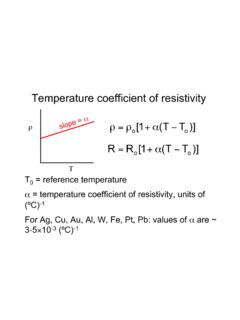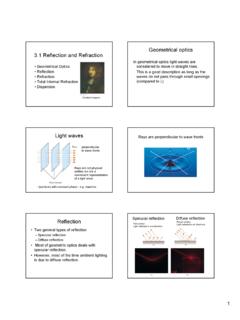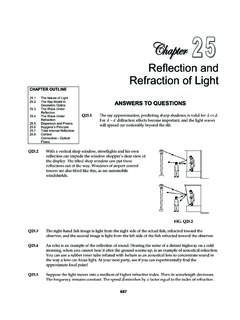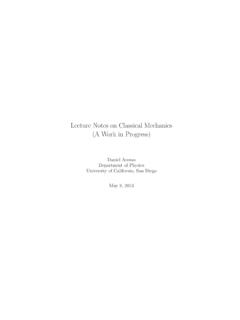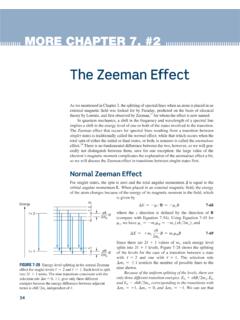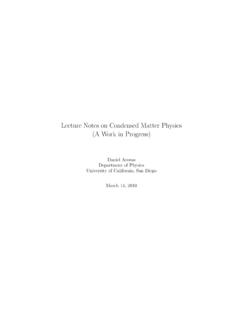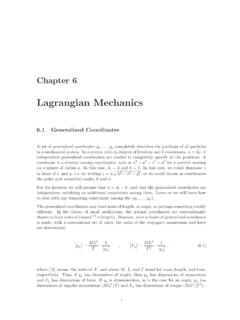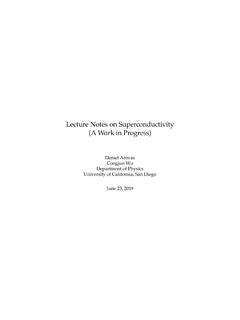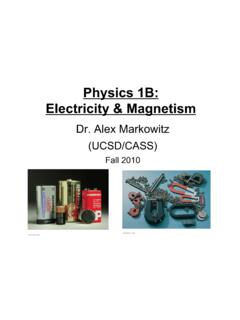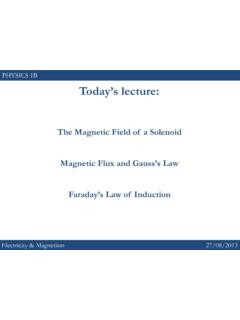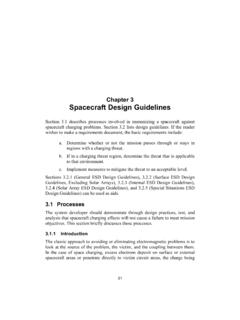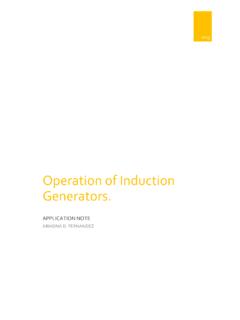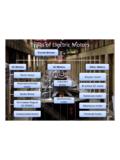Transcription of Electric Field due to a point charge - Physics Courses
1 Electric Field due to a point chargeE is a vector quantityMagnitude & direction vary withposition--but depend on object w/ charge Q setting up the fieldE- Field exerts a force on other point chargesrThe Electric Field depends on Q, not q0. It also depends on you replace q0 with q0 or 2q0, the strength & magnitude ofthe E- Field at that point in space remain the sameThe electrostatic FORCE, however, depends on Q AND q0as well as exerts force on a chargeConsider an array of + charges and an array of charges :+++++++++++++++ EE+q-qF= qECathode Ray ( )Anode(+)e EFAccelerating electrons in a constant E-fieldA single electron is accelerated from rest in a constantelectric Field of 1000 N/C through a distance of 3 cm. Findthe Electric force on the electron, and calculate its finalvelocity (me = kg)EF = qE = meaF = qE = ( 19 C)(1000N/C)= 16 N-ElectrophoresisSeparation of DNA segments (q ~ 1000 e due to O s inphosphate backbone of DNA chain) in an E- Field ~ 1000 through pores in gel towards anode; smallersegments travel furtherSource: : Ink-jet printersTiny drop of ink is shotthrough charging unit,where a negative charge (typ.)
2 ~ 1000e) is E- Field is then appliedto deflect the drop throughthe proper s Oil Drop ExperimentMillikan s Oil Drop ExperimentEvery droplet contained an amount of charge equalto 0e, 1e, 2e, 3e,..Conductors in Electrostatic EquilibriumLike charges repel and can move freely along electrostatic equilibrium, charges are not moving4 key properties:1: charge resides entirely on its surface (like chargesmove as far apart as possible)---------------2: Inside a conductor, E- Field is zero(if there are charges , anE- Field is established,and other charges wouldmove, and conductorwouldn t be atequilibrium)---------------E=02: Inside a conductor,E- Field is zeroTrue for a conductorwith excess chargeAnd for a conductor inan external E- Field :E=0---------------E=0---+++3: E- Field just outside the conductor isperpendicular to its surfaceAny non-perpendicularcomponent would causecharges to migrate, therebydisrupting equilibrium4.
3 charges accumulate at sharp points (smallestradius of curvature)Here, repulsiveforces are directedmore away fromsurface, so morecharges per unit areacan accumulateFaraday s ice-pail experimentIn a conductor: free charges reside on its surfaceElectrometer attached toOUTER surface:measures amount ofcharge on outer surfaceMetal ice-pail: insulated from groundFaraday s ice-pail experimentIn a conductor: free charges reside on its surface+ s attracted to innersurface- s repelled to outer surfaceCharge on outer surface issame sign as charge onmetal ballFaraday s ice-pail experimentIn a conductor: free charges reside on its surfaceNeedle on electrometer does notmove!CONTACT:Negative charge on balland positive charge oninner surface neutralizeeach otherFaraday s ice-pail experimentNeedle on electrometer stilldoes not move!Remove ball:Conductors in Electrostatic EquilibriumSuppose you had a pointcharge +q.
4 You surroundthe charge with aconducting spherical happens?+qConductors in Electrostatic Equilibrium+q- s accumulate on innersurface. + saccumulate on outersurfaceE- Field within conductoris zeroFrom very far away, Field lines look exactlyas they did before++++++++++++ Van de graff GeneratorsPositively-charged needles incontact w/ belt: pulls over e sLeft side of belt has netpositive chargePositive charges transferred to conductingdome, accumulate, spread outPositive charges transferred toconducting dome, accumulate, spreadoutE- Field eventually gets high enough toionize air & increase its conductivity-- getmini-lightning boltsBoston Museum of Science / Electric Field strength needed to ionize air and allow itto conduct electricity is 3 x 106 N/CThe maximum charge that can be accumulated on thedome WITHOUT having electrical discharge in thevicinity of the dome can be calculated viaEmax,VdG = 3 x 106 N/C = ke Q / r2where r is the radius of the domeVdG generator at Boston Museum of Science(largest air-insulating VdG in the world):lightning travels along outside of operator's conducting cage: (fast forward to ~1:10)Another example of a faraday cage.
5 (Tesla coil, not VdG generator, used to generate the lightning): VdG Electric Flux & Gauss LawOVERVIEW:Gauss Law: relates Electric fields and the chargesfrom which they emanateTechnique for calculating Electric Field for a givendistribution of chargeRelates the total amount of charge to the electricflux passing through a closed surface surroundingthe charge (s). Electric FluxReminder: Total number of Field lines prop. to totalcharge. Density of E Field lines in a given part of spaceis prop. to magnitude of EqElectric FluxReminder: Total number of Field lines prop. to totalcharge. Density of E Field lines in a given part of spaceis prop. to magnitude of EElectric flux: a measure of how much electricfield vectors penetrate a given surfaceqElectric FluxReminder: Total number of Field lines prop. to totalcharge. Density of E Field lines in a given part of spaceis prop.
6 To magnitude of EElectric flux: a measure of how much electricfield vectors penetrate a given surfaceqGauss' Law (qualitative):Surround the charge by a closedsurface. The density of E-fieldlines at the surface can be relatedto the enclosed chargeElectric Flux EConsider a uniform E- Field and an area A toE- Field lines: E = E AIf E- Field lines make angle to normal of plane: E = E A cos Electric Flux E Through a CubeUniform E- Field parallel to x-axis: What s the net E through the cube?Normal vectorpoints outward fora closed surfaceElectric Flux E Through a CubeUniform E- Field parallel to x-axis: What s the net E through the cube? E = E A cos Top & Bottom: E = E A cos(90 ) = 0 Each side: E = E A cos(90 ) = 0 Surface2: E = E A cos(0 ) = +EL2 Surface1: E = E A cos(180 ) = EL2 Net E = 0+0+0+0+ EL2 - EL2 = 0 Normal vectorpoints outward fora closed surfaceThe net Electric flux through anyclosed surface will be zero ifthere is no charge enclosedinside!
7 Gauss Law E = Qencl / 0 E through any closedsurface is equal to thenet charge enclosed,Qencl, div. by 0 Gauss LawGauss Law: describes how charges create electricfieldsGaussian surfaces: not a real surface -- does not haveto coincide with the surface of a physical object E does not depend on radius of sphere: just thecharge enclosed (1/r2 dependence of E cancelled byr2 dependence of A)Sample Gaussian surfacesHint: Choose surfaces such that E is or || to surface!Gauss Law: A sheet of chargeDefine = charge per unitareathese following slides we did not get to on Wednesdaybut we will view them on Thusday right after the quizGauss Law: Charged Spherical ShellAt r < a: E = Law: Charged Spherical ShellAt r > b, E looks like that from a single point charge QDivide both sides by area:4 0r2E=QenclE4 r2 Gauss Law: 2 planes with opposing chargesGauss Law: 2 planes with opposing charges + + + + + + +_ _ _ _ _ _ _+ + + + + + +_ _ _ _ _ _ _E= /(2 0)E=+ /(2 0)E=+ /(2 0)E= /(2 0)Gauss Law: 2 planes with opposing charges + + + + + + +_ _ _ _ _ _ _Inside:E=+ /(2 0)+ /(2 0)= / 0E=0 outsideE=0 outsi
